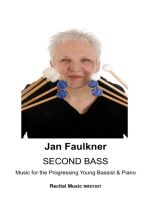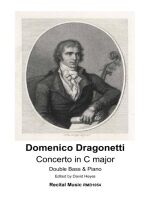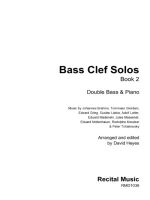Harmonious Harmonics
Trios & Quartets for Double Bass

Double Bass Trio & Quartet
Composer: David Heyes, Antonio Salieri
Product code:
RMD1120
Publisher: Recital Music
£10.00
Description
HARMONIOUS HARMONICS consists of five quartets, one canon, two rounds, and a three movement Suite for Emma composed by David Heyes. They are all designed as a simple, straightforward and unthreatening introduction to harmonics on the double bass. All the pieces have been successfully performed at workshops and concerts around the world, each part carefully graded for a specific ability level.
The canon and rounds are slightly more challenging than the quartets, but a simple and repetitive accompaniment can be devised for less experienced players. In each quartet Bass 1 has the majority of the melodic interest, with Bass 2 often playing a third below. Bass 3 and 4 use a limited number of notes, in an accompanying role, enabling players of all abilities to play together.
There are many ways to play these short pieces and students should be encouraged to develop their own interpretation and performance ideas.
Kum-ba-ya has been particularly popular, performed in America by 65 bassists, and a simple and effective concert plan is:
1st time – all play Bass 4 / 2nd time – add Bass 3 / 3rd time – add Bass 2
4th time – add Bass 1 / 5th time – one solo player on Bass 1 and Bass 4 with everyone joining in for the final chord. This plan can be employed in each of the quartets, to create a longer concert item, but the possibilities are endless.
A Harmonic Chart on page 8 includes the basic harmonics playable on each string alongside the harmonics used by each part in the quartets.
A few things to remember when playing harmonics:
the bow should be played towards the bridge
lighten the bow pressure and the bow has to keep moving for the harmonic to sound touch the harmonic lightly with your finger
only place one finger on the string at any time
enjoy the music and aim for a clear and ringing tone
Look Inside
Description
HARMONIOUS HARMONICS consists of five quartets, one canon, two rounds, and a three movement Suite for Emma composed by David Heyes. They are all designed as a simple, straightforward and unthreatening introduction to harmonics on the double bass. All the pieces have been successfully performed at workshops and concerts around the world, each part carefully graded for a specific ability level.
The canon and rounds are slightly more challenging than the quartets, but a simple and repetitive accompaniment can be devised for less experienced players. In each quartet Bass 1 has the majority of the melodic interest, with Bass 2 often playing a third below. Bass 3 and 4 use a limited number of notes, in an accompanying role, enabling players of all abilities to play together.
There are many ways to play these short pieces and students should be encouraged to develop their own interpretation and performance ideas.
Kum-ba-ya has been particularly popular, performed in America by 65 bassists, and a simple and effective concert plan is:
1st time – all play Bass 4 / 2nd time – add Bass 3 / 3rd time – add Bass 2
4th time – add Bass 1 / 5th time – one solo player on Bass 1 and Bass 4 with everyone joining in for the final chord. This plan can be employed in each of the quartets, to create a longer concert item, but the possibilities are endless.
A Harmonic Chart on page 8 includes the basic harmonics playable on each string alongside the harmonics used by each part in the quartets.
A few things to remember when playing harmonics:
the bow should be played towards the bridge
lighten the bow pressure and the bow has to keep moving for the harmonic to sound touch the harmonic lightly with your finger
only place one finger on the string at any time
enjoy the music and aim for a clear and ringing tone



